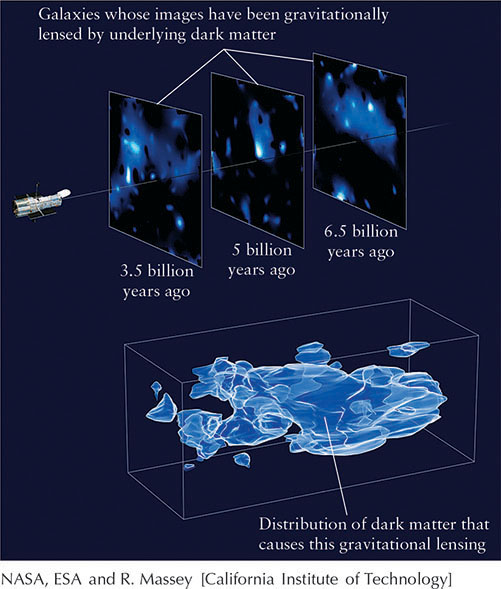A Brief History of Spacetime, Matter, Energy, and Everything
The composition of the universe during its first few minutes of existence was profoundly different from what it is today. To understand why, we need to expand briefly on the nature of the four known physical forces: gravity, electromagnetism, and the strong and weak nuclear forces.
536
18-6 All physical forces in nature were initially unified
Only the effects of electromagnetism and gravity can extend over infinite distances. The electromagnetic force holds electrons in orbit around the nuclei in atoms, which allows normal matter to exist. However, over large volumes of space, the net effects of electromagnetism cancel out because a negative electric charge exists for every positive charge and a south magnetic pole exists for every north magnetic pole.
 Although gravity is the weakest of all four forces, it is the only force whose effect is both infinite in extent and attractive for all matter and energy. Those characteristics are why gravity determines the evolutionary behavior of stars, the orbits of planets, the existence of galaxies, and many other large-scale phenomena. Indeed, the attractive force of gravity dominates the universe at astronomical distances. (Despite all of this, we will learn shortly that, under certain conditions, gravity may have a repulsive component.)
Although gravity is the weakest of all four forces, it is the only force whose effect is both infinite in extent and attractive for all matter and energy. Those characteristics are why gravity determines the evolutionary behavior of stars, the orbits of planets, the existence of galaxies, and many other large-scale phenomena. Indeed, the attractive force of gravity dominates the universe at astronomical distances. (Despite all of this, we will learn shortly that, under certain conditions, gravity may have a repulsive component.)
In contrast to gravity and electromagnetism, both the strong and the weak nuclear forces act over extremely short ranges. Their influences extend only over atomic nuclei, distances less than about 10−15 m. The strong nuclear force holds protons and neutrons together. Without this force, all nuclei other than hydrogen would burst apart because of the electromagnetic repulsion of their positively charged protons. Thus, the strong nuclear force overpowers the electromagnetic force inside nuclei.
The weak nuclear force is at work in certain kinds of radioactive decay, such as the transformation of a neutron into a proton. Protons and neutrons are composed of more basic particles, called quarks. A proton is composed of two “up” quarks and one “down” quark, whereas a neutron is made up of two “down” quarks and one “up” quark. The weak nuclear force is at play whenever a quark changes from one variety to another. For example, in one kind of radioactive decay, a neutron transforms into a proton as a result of one of the neutron’s “down” quarks changing into an “up” quark.
To examine details of the physical forces, scientists use particle accelerators that hurl high-speed particles at targets. High speed is equivalent to high energy and therefore high temperature. In such experiments, physicists find that at sufficiently high temperatures, the different forces begin to behave the same way. For example, at extremely high temperatures, the electromagnetic force, which works over all distances under “normal” circumstances, and the weak force, which only works over very short distances under the same “normal” circumstances, become identical. They are no longer separate forces, but become a single force called the electroweak force. The experiments verifying this were done at the CERN particle accelerator in Europe in the 1980s.
Theories have also been developed that describe conditions under which the electromagnetic, weak, and strong forces all have the same strength (that is, when they act as one). These Grand Unified Theories (or GUTs) describe how the energies or, equivalently, temperatures at which this unification of forces occurs are greater than can ever be achieved in any laboratory on Earth. But recall from the earlier discussion that when the universe was young, it was very hot—hot enough for this unifying of forces to occur. Detailed calculations reveal that in the first 10−35 seconds of existence, the temperature of the universe was more than high enough for the electromagnetic, weak, and strong forces to have the same strength.
The relationship between gravitation and the other three forces is still uncertain. Scientists have not yet been able to include gravity’s effects in a single theory with the weak, strong, and electromagnetic forces. Efforts to create such a theory are under way, under the general name Theory of Everything. Mathematical formulations of this theory include loop quantum gravity and superstring theory, are being developed, although these theories do not yet make predictions that scientists have been able to test (putting them on the outskirts of science). Assuming gravity will be joined to the other forces, we include its expected effects here. Figure 18-7 shows that, during the beginning moments of the universe (from 0 to 10−43 seconds, called the Planck era), the four forces are believed to have all been unified—only one physical force existed in nature. However, as it assumes a Theory of Everything force exists, this assumption remains to be proven.
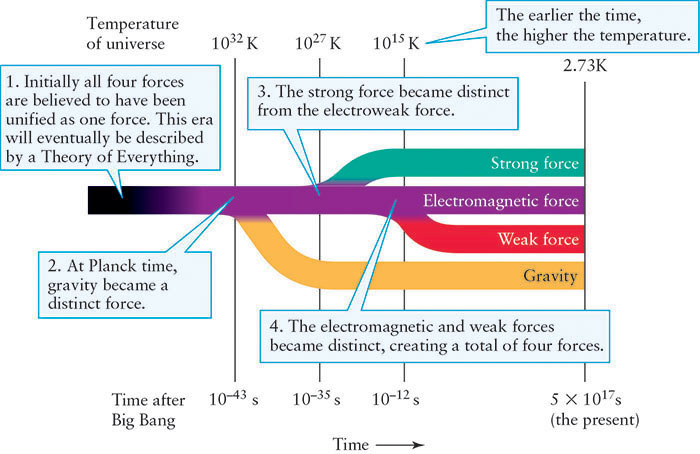
Different Realms of Science Are Working Together
Because physicists who study elementary particles have no hope of building accelerators powerful enough to test the unified theories of fundamental forces described here, they have joined with astrophysicists and astronomers to use the entire universe as a large laboratory. If there is a way to see, even indirectly through remnants of events, what happened during the earliest moments of the universe, they could use those observations to test the theory. Amazingly, such observations can be, and are being, made.
18-7 Equations explain the evolution of the universe, even before matter and energy, as we know them, existed
The earliest time at which our current equations can explain the behavior of the universe is about 10−43 s after the Big Bang. This is called the Planck time, in honor of Max Planck, who helped derive some of the fundamental quantum physics that was used to calculate this time. The Planck time denotes the end of the Planck era. At the Planck time, gravity is thought to have become a separate force, leaving electromagnetism and the weak and strong nuclear forces still united as the GUT force. Which of the present GUT models, if any, is correct, remains to be seen.
537
The Planck time corresponded to when the currently observable universe was much smaller than the size of an atom today. Keep in mind that the universe was not (and is not) expanding into preexisting spacetime. Rather, the expansion was (and is still) creating spacetime. Therefore, you could not stick a thermometer into the early universe from “outside” to take its temperature. However, we can calculate the total amount of energy in the universe at the Planck time, and it corresponds to a temperature then of about 1032 K. There were no separate particles and electromagnetic radiation then, just gravitation and the GUT force, so matter as we now know it did not exist.
During the first 10−35 seconds of the universe’s existence (the blink of an eye takes about one-tenth of a second), calculations indicate that the expanding universe cooled to 1027 K (Figure 18-8). (For comparison, room temperature is about 300 K.) By then, the energy in each volume of the universe had decreased to the point at which the strong nuclear force could no longer remain unified with the electromagnetic and weak nuclear forces. At that instant, the strong nuclear force emerged (see Figure 18-7), distinct from the other two forces, which remained together as the electroweak force. For a short period, then, there were three forces in nature: gravitation, the strong nuclear force, and the electroweak force.
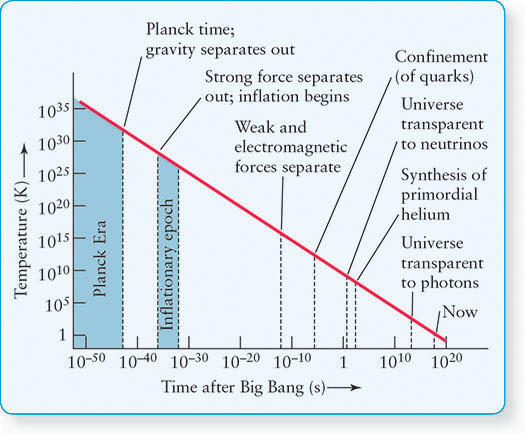
Margin Question 18-6
Question
Which fundamental force is essential in the process of nuclear fusion?
Many astronomers hypothesize that during the time that the strong force was decoupling from the electroweak force, the universe was in an unstable state, called a false vacuum. It was unstable in the same sense as you would be if you woke up one day to find yourself on a greased, half-meter wide shelf on the face of a cliff thousands of meters above the cliff bottom. The slightest move and you slide off and fall. Analogous to the transition you make by falling off the shelf, the young universe is believed to have suddenly made a transition (Figure 18-9) into a stable true vacuum state. The universe’s transition to the true vacuum state caused its expansion to momentarily accelerate.
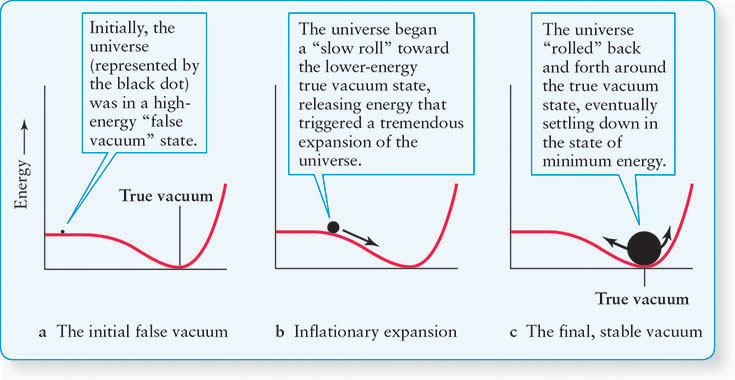
538
As the universe began moving toward the true vacuum state, it was already expanding. The transition caused the expansion rate to increase dramatically. From about 10−36 seconds until about 10−32 seconds after the Big Bang, the universe ballooned outward about 1050 times larger (Figure 18-10). The currently observable universe expanded to about the size of a soccer ball. This huge rate of expansion of the universe is termed inflation. Shortly after inflation ended, at about 10−12 seconds after the Big Bang, the weak and electromagnetic forces became separate, heralding the first formation of elementary particles: quarks, electrons, photons, neutrinos, and their antiparticles.
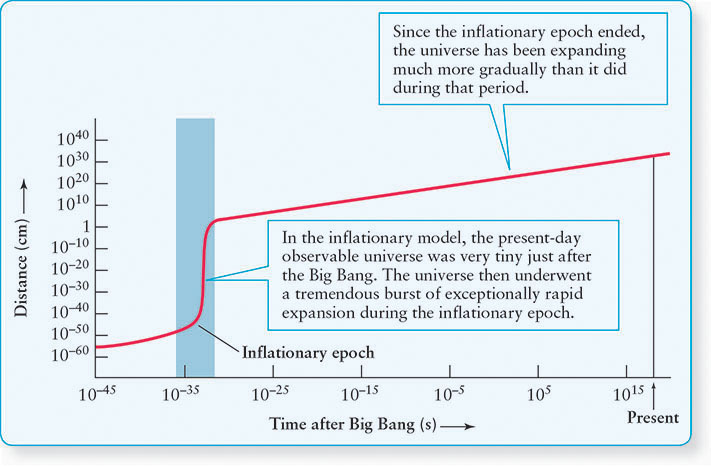
18-8 Homogeneity and isotropy are results of inflation
Because disorder is more likely to occur than order in nature, astronomers theorize that the matter and energy in the early universe were distributed chaotically and expanded turbulently. That is also why an explosion on Earth expands turbulently, with lots of swirling gases, rather than expanding smoothly, like the surface of a balloon as it is being inflated. As a result, some places in the early universe had higher temperatures than others. If the universe had never undergone inflation, but had continued expanding only at the rate calculated for its motion at the Planck time, today we should be able to see different parts of the universe with significantly different temperatures. However, as we saw in Figure 18-5, the temperatures of every region of the universe are the same to within a very tiny fraction of 1 K. This situation is called the isotropy problem or horizon problem. Realizing how uniform the universe’s temperature is, astronomers have hypothesized that inflation very early in its existence smoothed out the universe that we can see.
During the so-called inflationary epoch, the universe became so large that today we can see only a tiny portion of it. We are limited in what we can see by the speed of light. Recall that light takes time to travel from astronomical objects to Earth. We see the Sun, for example, as it was about 8 minutes ago. The farther we look into space, the further back in time we are seeing. Because the universe came into existence about 13.8 billion years ago, we cannot see objects that are farther than 13.8 billion light-years away from Earth (see the caveat about this number in the caption to Figure 18-11).
At a distance of 13.8 billion light-years, we see objects like galaxies and clusters of galaxies as they were just being formed. But because of inflation, the matter comprising these apparently distant objects was once extremely close to us. At that early time, before inflation, these objects had the same temperature, pressure, and density as the matter and energy in our nearest neighborhood of the cosmos. As the universe inflated, that nearby matter and energy became much more distant but maintained those properties. Therefore, the most distant reaches of space we can see are composed of matter and energy with the same characteristics as in our present neighborhood of the universe. That is why the visible universe appears uniform (homogeneous and isotropic).
Margin Question 18-7
Question
Why is inflation a necessary part of the Big Bang theory of cosmology?
539
Despite being able to see so far away, there is still much of the universe we cannot see. All that we can see from Earth is contained in an enormous sphere (Figure 18-11). The boundary of this sphere is called the cosmic light horizon. Light from all of the luminous objects in this volume has had time to reach Earth, but light from objects beyond the cosmic light horizon has not yet arrived here, so we are unaware of objects in these regions. As time goes on, we will be able to see objects farther from us.
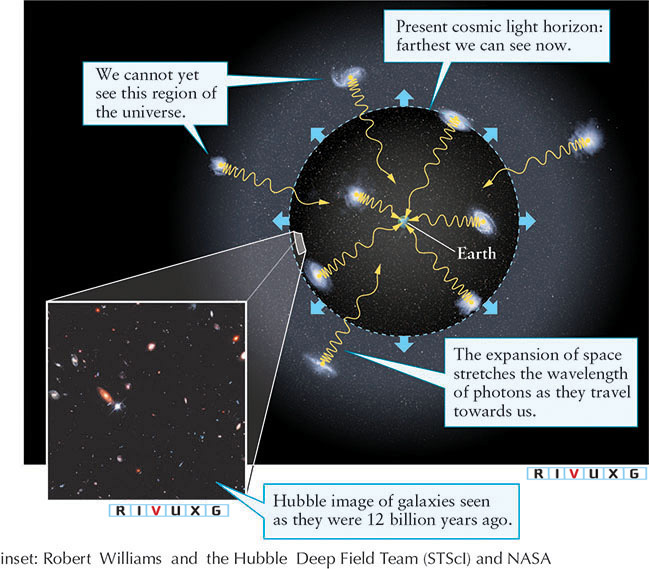
18-9 During the first second, most of the matter and antimatter in the universe annihilated each other
When inflation ended, the universe resumed the relatively leisurely expansion initiated by the Big Bang (see Figure 18-10) that continues today as the Hubble flow (see Section 16-12). Arriving at the time 10−12 seconds, when the temperature of the universe had dropped to 1015 K, the electromagnetic force separated from the weak nuclear force (as noted in Section 18-7; see also Figures 18-7 and 18-8). It is also likely that dark matter formed by this time, but because we know virtually nothing of its nature, we can only acknowledge its existence. From that moment on, all four forces interacted with particles essentially as they do today. At 10−12 seconds, the universe’s matter was primarily the individual building blocks of protons and neutrons—namely quarks, antiquarks, and the other elementary particles: neutrinos, antineutrinos, electrons, and positrons.
The next significant event is calculated to have occurred at 10−6 seconds, when the universe’s temperature dropped to 1013 K. Just as it is energetically favorable for boiling water to turn into gas, the temperature of the universe was so high before this time that it was energetically favorable for quarks to exist as isolated particles, rather than to combine in twos and threes to create the particles that exist in the universe today. We know they were initially isolated because similar seas of quarks were recreated under equivalent conditions in the laboratory in 2001 by smashing dense atoms together. After 10−6 seconds, a period appropriately called confinement, the universe was sufficiently cool so that quarks could finally stick together to form individual protons, neutrons, and their antiparticles. Figure 18-8 summarizes the connections between particle physics and cosmology.
The photons in the early universe contributed to the existence of particles back then. Equations show that early in the first second, the universe was so hot that virtually all photons were gamma rays possessing incredibly high energies. These energies were high enough so that photons could be transformed into matter and antimatter, according to Einstein’s equation E = mc2. This process is the reverse of what we saw in Section 10-7, where we discussed how matter is converted into energy in nuclear fusion. To make a particle of mass m, you need a photon with energy E at least as great as mc2, where c is the speed of light.
540
The creation of matter from energy is routinely observed in laboratory experiments that involve high-energy gamma rays. A highly energetic photon colliding with an atomic nucleus can create a pair of particles (Figure 18-12a). This process, called pair production, always creates one ordinary particle and its antiparticle. For example, if one of the particles is an electron, the other is an antielectron, also called a positron. (Recall from Section 14-11 that similar pairs of particles are also believed to be produced near a black hole.)
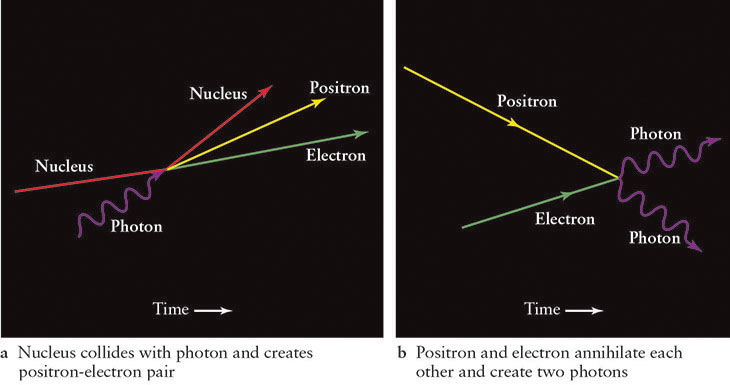
A positron has all the same properties as an electron except for having an opposite charge. When an electron and a positron meet, they annihilate each other and their energy is converted into photons (Figure 18-12b). Theory predicts that at times earlier than 1 second in the evolution of the universe, photon collisions created vast numbers of pairs of particles. Consequently, shortly after the Big Bang, all space was chock-full of protons, neutrons, electrons, neutrinos, their antiparticles, and dark matter, all immersed in a phenomenally hot bath of high-energy photons.
As the universe expanded, the temperature decreased; after the first second it was sufficiently cool so that photons could no longer create pairs of particles and antiparticles. Particles and antiparticles continued to collide, however, annihilating each other and converting their masses back into high-energy photons, but nothing could replenish the dwindling supply of particles and antiparticles.
If all particles had annihilated their antiparticles in the early universe, no matter would be left at all and we would not be here. And yet, here we are and astronomers observe very few antiparticles in the universe (see, for example, Section 15-4). Because particles and antiparticles are always created or destroyed in pairs, why aren’t they found in equal numbers in the universe today, or rather, why didn’t they all destroy each other shortly after they were created?
Physicists theorize that the symmetry or equality between the number of particles and the number of antiparticles in the early universe was broken by the weak force—a symmetry breaking. This effect has been observed on Earth in high-energy particle accelerators over the past half century. Due to symmetry breaking, the number of particles was actually slightly greater than the number of antiparticles in the early universe. For every billion antiprotons, perhaps a billion plus one protons formed; for every billion antielectrons, a billion plus one electrons formed. Virtually all of the antiparticles created in the first second of time annihilated normal particles shortly thereafter. The remaining particles in the universe today are the slight excess of normal matter created as a result of this symmetry breaking.
18-10 The universe changed from being controlled by radiation to being controlled by matter
As the universe expanded and cooled further, the remaining protons and neutrons began colliding and fusing together, a process called primordial nucleosynthesis. For the most part, the nuclei with two or more particles were quickly separated again by the gamma rays in which they were bathed, a process called nuclear fission. However, during the first 3 minutes, enough helium and lithium atoms were created (and not subsequently split apart) to form most of the free helium and at least 10% of the trace element lithium that exist today. A lithium atom has three protons and three neutrons. Hydrogen, helium, and lithium are the three lowest-mass elements. After a few minutes, the universe was too cool to allow fusion to create more massive elements, such as carbon and oxygen. All elements other than the three lowest-mass ones formed later, due to stellar evolution, as discussed in Chapters 10, 12, and 13.
Share Information
Although the evolution of the universe is a truly large-scale event, the activity in the first 3 minutes was nevertheless intimately connected to the creation and properties of elementary particles, the smallest objects in the universe. Physicists who study elementary particles and astrophysicists who study cosmology now regularly hold meetings to compare notes and connect their fields.
541
Calculations indicate that for tens of thousands of years, photons dominated the behavior of the universe in two important ways. One effect of the photons was to contribute to the gravitational attraction in the universe. This contradicts intuition, because photons are massless and mass is what we normally associate with causing gravitational attraction. Nevertheless, the gravitational contribution of photons to the universe is a tested prediction of general relativity. For about 30,000 years after the Big Bang, the energy density, and hence the gravitational effect, of photons was greater than the gravitational effect of matter. This situation was called the radiation-dominated universe.
The major effect of the radiation-dominated universe was that photons prevented matter from collapsing together and forming stars and galaxies. As the universe expanded, the gravitational effects of both photons and matter decreased as they became more spread out. The effect of photons decreased faster than that of matter (Figure 18-13) because the photons lost energy, and hence gravitational influence, due to the cosmological redshift, but particles with mass did not similarly lose mass or energy. After about 30,000 years, matter came to dominate the gravitational behavior of the universe, a situation that has persisted ever since. As a result, we live in a matter-dominated universe today. It was only after the universe became matter-dominated that gas could respond to gravitational interactions with other gas and begin clumping together where the force of gravity was sufficiently strong (an issue we explore further in a moment).
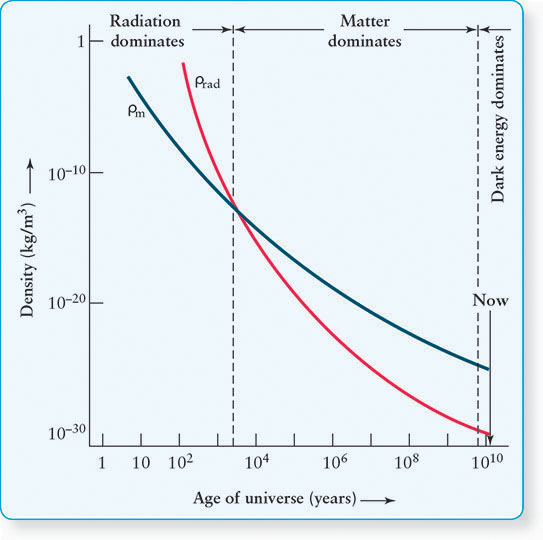
Photons dominated the early universe in another way for about the first 380,000 years. The photons back then could travel only short distances before they collided with particles. These interactions prevented electrons from settling into orbit around nuclei—as soon as electrons did so, photons struck them and kicked them out of orbit, a process called ionization (see Section 4-5). During that epoch, the universe was completely filled with a shimmering expanse of high-energy photons colliding vigorously with nuclei and electrons. This state of matter, in which nuclei and electrons are separated from each other, is called a plasma. In such an environment you would see a glow from local photons, but because of their vigorous interactions with matter you would not be able to see photons from even a few meters or yards away (Figure 18-14a). The term primordial fireball describes the universe during this time.

By around 380,000 years, the universe was so large that the cosmological redshift had stretched photon wavelengths (see Figure 18-1) and thereby decreased photons’ energies to the point where they could no longer ionize hydrogen. This stage is called decoupling, meaning that the massive particles and the photons were effectively disconnected from each other. Electrons began orbiting nuclei, thereby creating neutral atoms (Figure 18-14b). The distance between atoms became so large that most primordial photons now passed by them, rather than colliding with them. Without these collisions to scatter photons, the universe ceased being hazy. It became clear, as it is today, enabling electromagnetic radiation to travel long distances unimpeded and, important from an astronomer’s point of view, enabling us to see far into the universe today.
Margin Question 18-8
Question
How, if at all, would the universe be different if antiparticles had exceeded particles in the symmetry breaking described here?
This dramatic period, when the universe transformed from being opaque to transparent, took about 50,000 years to complete and is referred to as the era of recombination, referring to nuclei and electrons combining. There are many instances, both in space and in the laboratory, where electrons are stripped from atoms. After such ionization occurs, electrons often recombine with nuclei to recreate neutral atoms. However, the gases created early in the evolution of the universe were never neutral, so the “re” in recombination is misleading. Because the universe was opaque in its first 380,000 years, we cannot see any further into the past than the era of recombination with telescopes that detect electromagnetic radiation of any wavelength.
Margin Question 18-9
Question
We say that “most” of the helium in the universe was formed in primordial nucleosynthesis. Where was/is the rest of it formed?
542
We can use Wien’s law to calculate that the cosmic background radiation had a temperature of 3000 K at the era of recombination. Such a blackbody has a peak microwave wavelength of 0.001 mm. The temperature history of the universe is graphed in Figure 18-8.
Since the primordial gamma-ray photons formed, the expansion of the universe has been increasing their wavelengths, so today we see these same photons as the cosmic microwave background. The universe is now about 1000 times larger than it was at decoupling. Although the universe is dominated by matter today, the number of photons left over from the Big Bang is still immense. From the physics of blackbody radiation, astronomers calculate that there are now 400 million cosmic background microwave photons in every cubic meter of space. In contrast, if all visible matter in the universe were uniformly spread throughout space, there would be roughly one hydrogen atom in every 3 cubic meters of space. In other words, photons continue to outnumber atoms by more than a billion to one. The microwave background contains the most ancient photons we expect ever to be able to observe.
18-11 Galaxies formed from huge clouds of primordial gas
The Big Bang theory explains the evolution of spacetime, matter, and energy since the Planck era. It accounts for the hydrogen, most of the helium, and some of the lithium that exist today. But how do we explain the existence of superclusters of galaxies, clusters of galaxies, and individual galaxies?
Had the universe been perfectly uniform until the era of recombination (that is, everywhere perfectly homogeneous and isotropic), it would have been impossible for stars, galaxies, and larger groupings of matter to form, pulled together as they were by differences in mass density and hence gravitational attraction. Quantum theory is believed to have played a vital role during the inflationary epoch in creating the clumpiness that we observe today as superclusters of galaxies. In 1927, the British physicist Paul A. M. Dirac (1902–1984) concluded that the laws of nature allow pairs of particles to spontaneously appear, provided that they are identical to each other except for having opposite electric charges, and that they annihilate each other and disappear within a very short period of time, typically 10−21 seconds. As discussed in Section 14-11, these pairs are called virtual particles.
Normally, quantum fluctuations (the spontaneous formation of pairs of virtual particles) occur on the size scales of pairs of particles. However, the quantum fluctuations on microscopic scales that were occurring during the inflationary period were stretched by the inflation until they were large enough to affect the spacetime around them. Those particles created tiny regions of slightly higher temperature, density, and pressure in the inflating universe, like little firecrackers going off all over the place. Also like firecrackers, those events sent out sound waves that traveled through the rapidly expanding universe. These sound waves are believed to have led to the formation of superclusters of galaxies. Here is how that may have taken place.
Sound waves are waves that compress and rarefy (make thinner) the medium through which they travel. The rate at which these compressions and rarefactions in the air enter your ears each second, for example, determines the pitches of the sounds you hear. As quantum fluctuations stretched out in the early universe, they compressed the surrounding medium, sending out spherical sound waves, which traveled as long as the gas in the young universe could support them. The speed of these sound waves was impressive by everyday standards. Sound in our atmosphere travels at about 350 m/s (1100 ft/s). The sound waves generated in the inflating universe traveled at 1.75 × 105 m/s (5.75 × 105 ft/s).
543
The sound waves created at the end of inflation in the early universe traveled out through the plasma of the universe until decoupling, 380,000 years later. At that time, when photons no longer scattered quickly off the gas in the universe, the waves stopped moving.
Because those sound waves were compression and rarefactions of the gas in the young universe, when they stopped traveling they established shells of higher density gas (compressions) and interior regions of lower density (rarefactions). The slightly denser and slightly more rarefied regions of the universe that existed at decoupling were also slightly warmer and slightly cooler, respectively, than the average gas in the cosmos. Although those differences in temperature were incredibly small, they have been detected by careful analysis of the data from the COBE and WMAP satellites, which observed the cosmic microwave background temperature at the time of decoupling. Their data (Figure 18-15a) show that these variations in temperature were only about 1 part in 100,000, implying that the average density of matter in the early universe varied by a similar amount. Such tiny differences in density were nevertheless sufficient to start the process of supercluster, cluster, and galaxy formation.
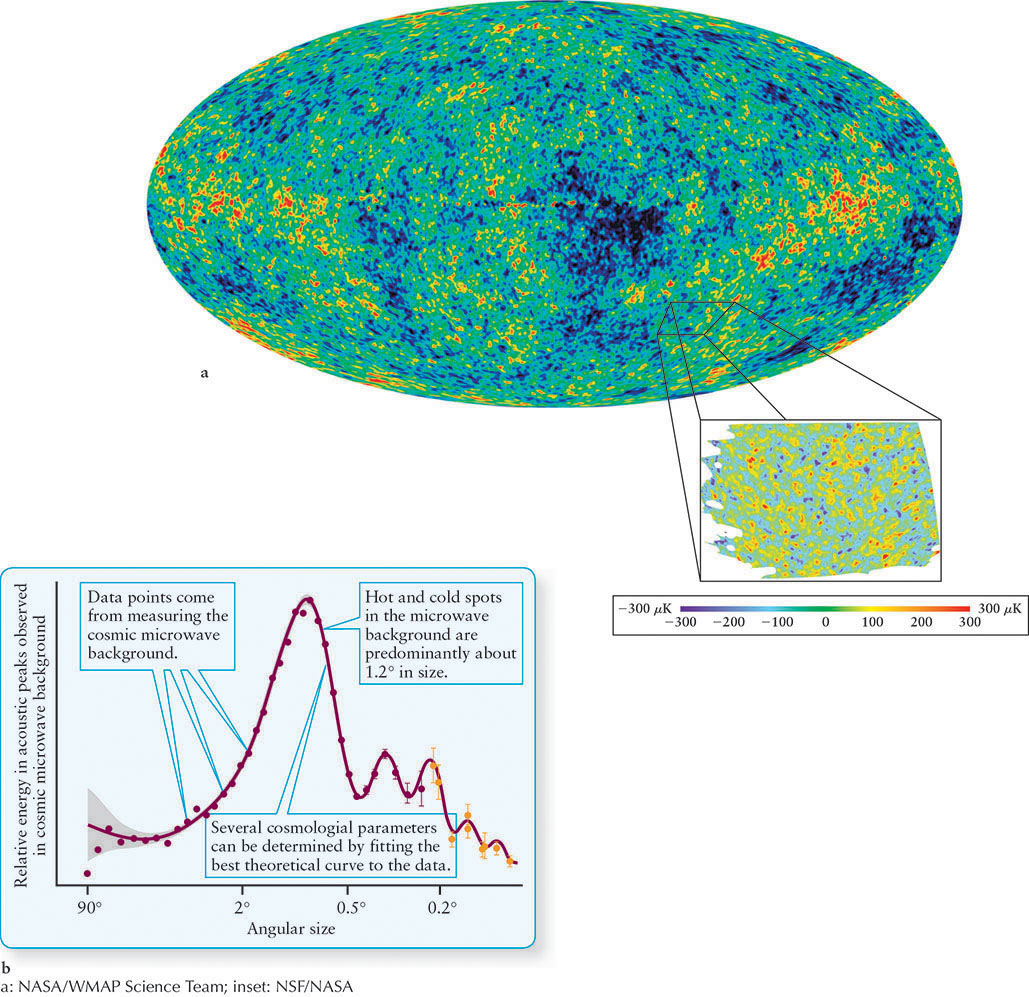
Astrophysicists have plotted the angular sizes of the peaks (warm regions) created by the acoustic (sound) waves, as shown in Figure 18-15b. Their sizes are clustered around 1.2° in angle (Figure 18-15b). In other words, the bubbles of sound generated by the quantum fluctuations spread out to that angular size, as seen from Earth some 13.8 billion light-years away. Allowing for the expansion of the universe since decoupling, those bubbles are about 960 million light-years in diameter today. This size is consistent with predictions of their properties made by the Russian physicist Andrei Sakharov (1921–1989) in 1965. Like the sound generated by a violin, there are overtones (higher pitches) in the peaks of the cosmic microwave background. These overtones have different amplitudes. Their relative amplitudes tell us the relative amounts of visible matter and dark matter in the universe, from which we conclude that there is about 5 times as much dark matter as there is visible matter.
544
We can now outline the scenario for how matter clumped in the early universe. When the universe was radiation-dominated, the particles in it were moving too fast to be pulled together and form structures, like stars, galaxies, clusters, or superclusters. During that time, sound waves from quantum fluctuations created growing shells of higher-density gases, surrounding regions of lower-density gases. Following decoupling, those shells stopped growing. The chemical composition of the early universe was 76% hydrogen and 24% helium, with trace amounts of lithium gas. It took time for the gas to cool sufficiently to start forming stars, a period called the dark ages. (Despite the name of that era, the hydrogen in the dark ages was emitting 21-cm photons, as discussed in Section 15-7. These photons have now been redshifted by the Hubble flow to tens of meters in length, which is where astronomers are looking for them.) Gravitational attraction in the gases on the shells ultimately led to the formation of superclusters, clusters of galaxies, and galaxies.
The voids seen throughout the cosmos (see Section 16-8) are the relatively empty spaces surrounded by shells of superclusters. The diameters of some of the voids have been measured. They are all 1 billion light-years or smaller, consistent with the 960 million light-year diameters of the shells on which superclusters formed. That not all voids are the same size comes from the fact that many shells of sound crossed each other before decoupling.
The first generation of stars are called Population III stars. Except for a trace of lithium, they were completely devoid of metals. Computer simulations indicate that many of these stars had masses in the range 100–500 M⊙. These behemoths were a million times or more brighter than the Sun, and they lived for no more than a few million years. Stars with between 100 and 250 M⊙ then exploded, while more massive stars collapsed and formed black holes without exploding. The stars in this early cohort that did explode provided the first metals in the universe (other than the primordial lithium). During the first billion years, it appears that clumps of gas that contained millions or billions of solar masses also collapsed to create supermassive black holes. These black holes would have attracted other matter into orbit around them and thereby served as the seeds for the formation and growth of some galaxies. Recent observations reveal that massive and supermassive black holes typically grow until they have about 0.2% of the mass of a disk galaxy’s central bulge.
If, as is now believed, some of the earliest stars had masses in the range of stars found in our Galaxy, it is possible that the lower mass (red dwarf) ones are still on the main sequence. In that case, some of these stars are still orbiting in galaxies like the Milky Way. Because they are Population III stars, astronomers are looking for them through their spectroscopic signature of having virtually no metal. At least one such star has been located. Analogously, astronomers have discovered two intergalactic clouds of gas that, to the precision of the observations, are composed just of hydrogen, helium, and a trace of lithium. They are remnants of the Big Bang that never became parts of galaxies, nor did they ever undergo star formation, which would have added metals to them.
By observing remote galaxies, astronomers have discovered that most galaxies initially emitted energy we associate with quasars and other active galaxies. This implies that most galaxies have supermassive black holes at their centers. The earliest quasars dating back to when the universe was only 900 million years old provide information about when the first stars formed. Those quasars have spectral lines created by iron and magnesium. In order for those elements to be in those quasars, the iron and magnesium had to be created in stars that formed 700 million years earlier (then exploded and put the metals into the interstellar medium). These metals were then attracted by the black hole. This scenario means that the first stars existed within 200 million years of the Big Bang (Figure 18-16a), thus defining the end of the dark ages.
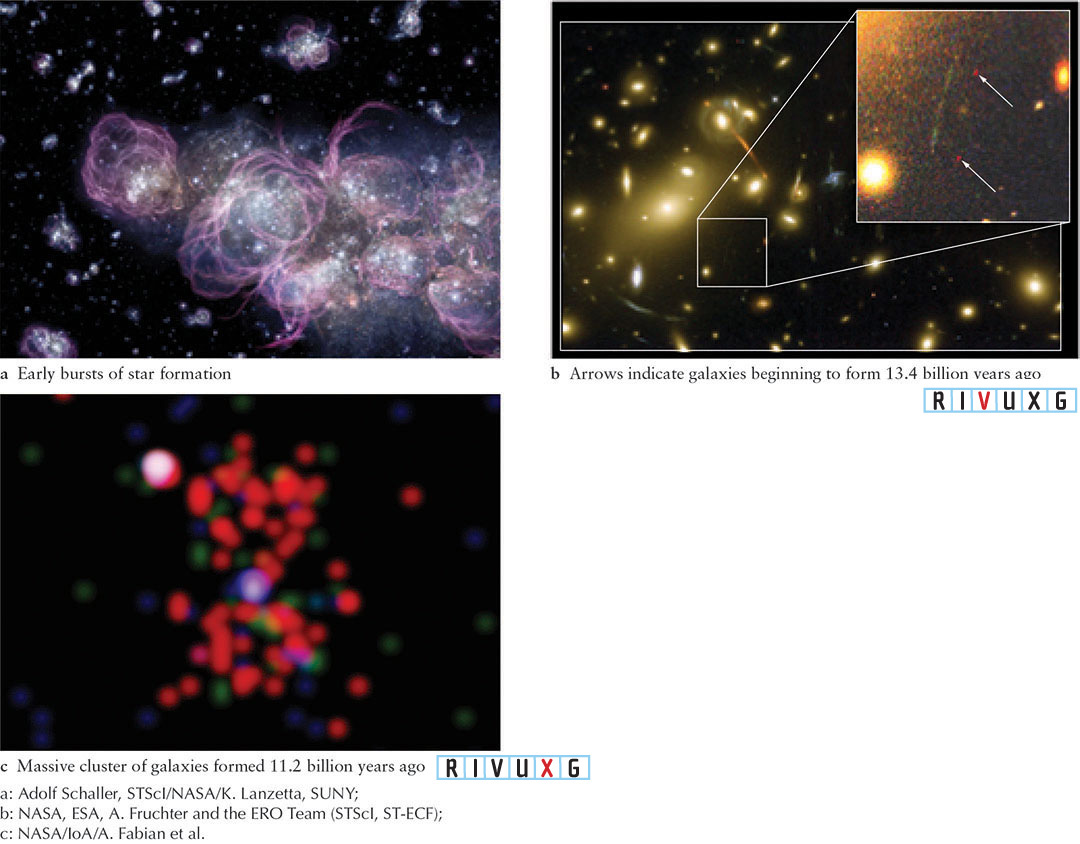
By 500 million years after the Big Bang, galaxies were beginning to coalesce (Figure 18-16b). We also have observational evidence that galaxies were in clusters within 2 billion years of the Big Bang (Figure 18-16c).
From about 600 million years to about 2.6 billion years after it formed, the universe underwent heavy star formation. Galaxies grew in size during this period, some continuously, others suddenly and quickly. Star formation decreased as the amount of interstellar hydrogen diminished. One observed galaxy, with about 8 times the mass in stars as the Milky Way has, reached its full star-forming potential when the universe was only about 800 million years old. About 2.6 billion years after the Big Bang there were so many quasars emitting so much energy that much of the gas in the universe became too hot to form new stars, as discussed in Section 17-5. For 500 million years, the star formation rate in galaxies back then decreased. As many quasars became quiescent, the star formation reignited and continued at very high levels until about 6 billion years after the Big Bang.
Margin Question 18-10
Question
If the first elements were hydrogen, helium, and lithium, where did Population II stars in globular clusters and elsewhere get their other metals?
545
Observations also reveal that galaxies were bluer and brighter in the past than they are today. These changes in color and brightness suggest a high abundance of young, bright, hot, massive stars in newly formed galaxies (Figure 18-17a). As galaxies age, these blue O and B stars become supergiants and eventually die. Therefore, galaxies grow somewhat redder and dimmer. This is especially true of those elliptical galaxies that formed early on. They appear to form nearly all of their stars in one vigorous burst of activity that lasts for about a billion years (Figure 18-17b), after which star formation diminishes drastically and their massive stars evolve and explode so that today we see in them primarily red, low-mass stars. Astronomers say that such elliptical galaxies are “red and dead.”

In contrast, spiral galaxies have been forming stars for at least the past 10 billion years, although at a gradually decreasing rate. There is still plenty of interstellar hydrogen in the disks of spiral galaxies, like our Milky Way, to fuel star formation today. That is why O and B stars still highlight their spiral arms. Figure 18-17b compares the rates at which spiral and elliptical galaxies form stars.
18-12 Star formation activity determines a galaxy’s initial structure
Imagine a developing galaxy, called a protogalaxy, forming from a cloud of gas. Theory proposes that the rate of star formation determines whether this protogalaxy becomes a spiral or an elliptical galaxy. If stars form slowly enough, then the gas surrounding them has plenty of time to settle by collision with other infalling gas into a flattened disk, just like the early solar system. Star formation continues because the protogalactic disk contains an ample supply of hydrogen, and a spiral or lenticular (disk-shaped but without spiral arms) galaxy is created. If, however, the initial stellar birthrate is high in the protogalaxy, the theory predicts that virtually all pregalactic gas is used up in the creation of stars before a disk can form. In this case, an elliptical galaxy is created. Figure 18-18 depicts these contrasting sequences of events.
546
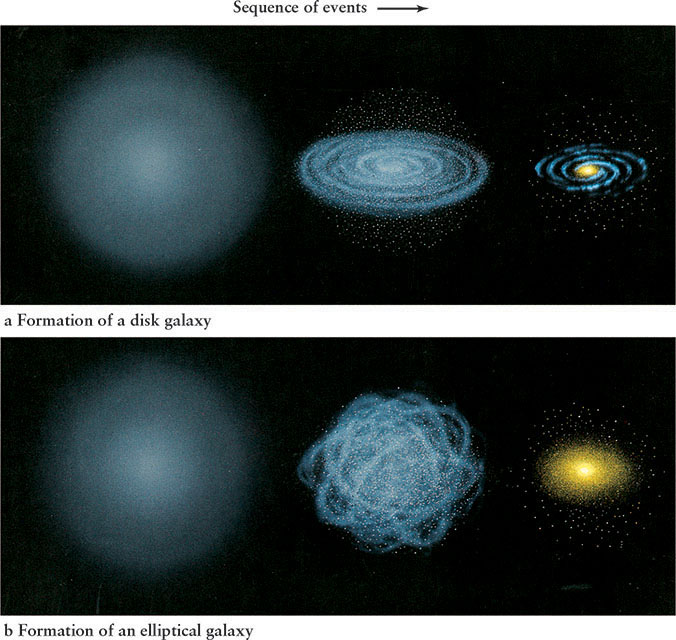
Not all galaxies maintain their initial structure over the evolution of the universe. As we discussed in Section 16-10, some galaxies collide, and these collisions can change a galaxy’s structure from spiral, for example, to elliptical. Indeed, astronomers who use extremely long exposures, called Hubble Deep Field images (for example, see the inset on Figure 18-11), have observed elliptical galaxies during the first few billion years of the universe’s existence that are far less uniform in color than are closer ellipticals. They observed blue stars in the young ellipticals consistent with the merger of spirals and a resulting burst of star formation, as well as lots of lower-mass (yellow and red) stars. Our understanding of galactic formation and evolution is far from complete.
Margin Question 18-11
Question
If dark matter did not exist, would any gravitational lensing occur in the universe?
547
Determining the location and nature of the dark matter in the universe (see Sections 15-7 and 16-11) is still of paramount importance in understanding the cosmos. The observable stars, gas, and dust in a galaxy or cluster of galaxies account for only about 10% to 20% of each object’s mass. (Recall that this observable matter does not have enough mass to hold galaxies or clusters of galaxies together.) We have very little idea of what the remaining 80% to 90% of each galaxy or cluster of galaxies is composed of. However, some progress in understanding the distribution of this dark matter is being made. In 2002, astronomers who map large numbers of galaxies and use computer simulations of the effects of dark matter determined that on the scales of clusters of galaxies, the locations of the galaxies often coincide with the concentrations of dark matter, while voids between clusters coincide with voids of dark matter. It is likely that the gravitational force of the dark matter caused gas to concentrate in the same regions, thereby stimulating formation of supermassive black holes and galaxies. In 2007, using images of galaxies that were focused by a gravitational lens of dark matter, astronomers were able to plot the locations of this dark matter (Figure 18-19).
